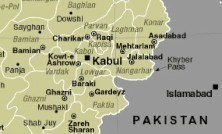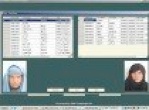Afghan Civil and Voter
Registration System
Afghan Civil and Voter
Registration System

The Customer Requirement
This CVR project is a component of UNDP Enhancing Legal and Electoral Capacity for Tomorrow (ELECT) Project to provide support to the Independent Election Commission (IEC) of Afghanistan in becoming a fiscally and institutionally sustainable administration with high integrity, capacity and resources to undertake elections in an increasingly fiscally sustainable manner by end-2008. For maximum utility of resources, a Joint Civil and Voter Registry project will produce an accurate and comprehensive national database of all its citizens. The national database will be used to produce and issue a national Identify document to all Afghan citizens that will serve as proof of identity. The national database and ID will serve multiple government departments will the government of Afghanistan eliminate various forms of identity fraud.
The ELECT Project is a component of the Afghan Compact that was agreed upon by the government of the Islamic Republic of Afghanistan and donors in London in January 2006.
The Ministry of Interior (MoI) and the Independent Electoral Commission (IEC) of Afghanistan are jointly planning to establish a Joint Civil and Voter Registry (CVR). The purpose of the Joint CVR System is to provide a National Identification System that will
a.Include biographic and biometric information on all Afghanistan citizens both male and female of all ages
b.Link each registered voter to a particular polling station.
c.Be used by various government departments and agencies for identification and authentication of individuals for various purposes
The Solution
The solution developed for the UNDP Afghan CVR project is based on a hybrid biometric system using iris recognition as well as face recognition systems. Two highly versatile and dynamic software applications developed by BioID have implemented this functionality for the pilot project. The CRM (Civil Registration Manager) is a multi-lingual, multipurpose software application that not only captures iris and facial images for the purpose of biometric enrollments, but also allows biographical data inputs for the registrant.. Added functionalities include support for Dari and Pashto and one click export of data from the database and burning to writable CDs.
The CRM Import Manager is a server software developed for the CVR pilot project. The import manager uses state of the art iris and facial recognition engines Template Server and ABIS that allows for duplicate analysis based on biometric match. It also performs database maintenance, generation of statistical reports using Crystal Reports components and imports the exported data from the clients into the main server.
The CRM Client Application
For hardware, the solution comprises of the highly robust and highly advances Securimetrics PIER-T Iris enrollment cameras whereas for facial recognition the Canon A640 digital cameras are used that produce high quality images of 10.0 mega pixels.
The PierT Iris Recognition and Canon A640 Facial Image capture devices
CVR Pilot Project 2007
The test phase of the CVR System was implemented simultaneously at three provinces Kabul, Nangarhar and Bamian in July 2007. A total of 13 registration sites throughout the country started registrations of voters for a period of 6 weeks. BioID developed the application, deployed the hardware and software and outsourced the daily management of the installation and enrollment operation with local staff. The central site was Kabul where the main server was installed.
The objective of the pilot project was to test the efficiency, accuracy, suitability and cost effectiveness of the registration procedures and technologies. This phase involved the use and testing of two biometric technologies: Facial Recognition and Iris Recognition as search tools for verification and identification of multiple registrations in the database. It tested the use of computerized data entry module. The target registration period was 6 weeks or a total of 30,000 registrations in all three provinces. Data synchronization was done through CDs brought back to Kabul from the sites. The data was to be analyzed for duplicates when imported to the central database.
The Enrollment Procedure
All registration centers were located in local villages in Bamian and Nangarhar and densely populated residential areas of Kabul city. Civic educators and public out-reach staff from the MOI and IEC campaigned to invite people to the registration centers for enrollment. Each site was equipped with one registration kit that contained the CVR system set (laptop, iris camera, facial camera and paper printer). Wherever needed, power was provided by using a small generator connected to a voltage stabilizer.
Every registrant passed through a process queue controller where his/her basic particulars were noted down on a pre-printed form. The registrant was then lead to the iris and facial enrollment station where iris scanning and facial image capture were performed. The last step was to capture all biographical particulars by interviewing the registrant and submitting the data set to the database.
There was no duplicate analysis performed on site which means every individual is registered. The individual is asked to sit in a chair while the operator enrolls the irises of both eyes. The iris capture device takes images of the iris and converts them to a digital code and assigns an ID code to that record before saving it to the database. This ID code is unique to that particular individual and is based on a series of numbers that contain site codes as well. There is also a family identifier number which relates to the head of the family and all other members of the family are enrolled under this number. The facial image capture is performed by allowing the individual to sit in a “mini studio” (with appropriate even background and sufficient lighting). The operators instruct the individual to face the camera and fine-tune lighting etc from the software. The image is taken through the software application and is submitted for quality checks on the PC. If the image is good enough and scores high on the quality checks, it is then saved to the database. The last step is to input the bio-data of the individual by direct interview and typing that data into a computerized form. Data retrieval is done by searching the record either by the ID number of the individual or the family number.
Data export files were burnt to writeable CDs twice a day to ensure that all data is safely exported. Data backups were also part of an automated system whereby data backups were taken at least once a day to an external USB powered hard drive.
The Infrastructure
All registration centers were equipped with a computer laptop connected to various other peripheral devices such as iris and facial cameras, paper printer and backup hard drive.
One of the customer requirements was that no duplicate analysis was to be done on site. Therefore, all data was brought back to the central office in Kabul where the data was imported and analyzed for duplication. Any individual who was enrolled more than once at the same or different site was identified after import. This was done using the facial and iris recognition engines in the CRM import manager.
Iris and Facial Match Lists
BioID was contracted to implement the installation and management of the entire installation on a turnkey basis including application development, on-site implementation and training, license management, procurement of hardware & software and supplies
BioID Technologies also provides the day-to-day management of all sites including support, problem escalation and resolve and implementation of warranties and supplier relations
Customer Satisfaction
The system is working to full satisfaction of the UNDP and all related stake holders exactly according to specifications. The systems have operated non-stop during the registration period. By the end of the registration period (August 2007), a total of 21,947 records were totaled to the central database. The customer also expressed total satisfaction with the quality of training given to registration staff by BioID. System Uptime has been 99.9% in challenging environmental conditions and system support has been round the clock on both domestic and international levels.













